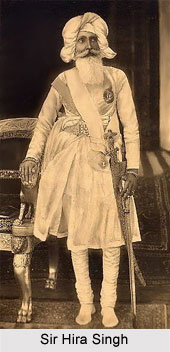 Sir Hira Singh was the ruler or Maharaja of Nabha State, which was one of the Phulkian states in Punjab. At present Nabha is in the modern Patiala district, in the state of Punjab. Singh was born on 18th December 1843 at Badrukhan, Jind, to Sardar Sukha Singh. He was the second son of Sukha Singh, who belonged to from a remote branch of the royal Sikh Phulkian dynasty of Nabha Patiala and Jind. His son, Sri Tikka Sahib Ripaduman Singh succeeded him to the throne of Nabha as the Maharaja, from the year 1911 to 1928.
Sir Hira Singh was the ruler or Maharaja of Nabha State, which was one of the Phulkian states in Punjab. At present Nabha is in the modern Patiala district, in the state of Punjab. Singh was born on 18th December 1843 at Badrukhan, Jind, to Sardar Sukha Singh. He was the second son of Sukha Singh, who belonged to from a remote branch of the royal Sikh Phulkian dynasty of Nabha Patiala and Jind. His son, Sri Tikka Sahib Ripaduman Singh succeeded him to the throne of Nabha as the Maharaja, from the year 1911 to 1928.
Rule of Sir Hira Singh
After the death of the young ruler Bhagwan Singh in the year 1871, the lineage of the Phulkian dynasty became extinct. This dynasty had ruled over the region of Nabha since 1718. In merger with the British administration, the remaining 2 lines of the Phulkian dynasty, rulers of Patiala and Jind, selected Hira Singh as the successor to the throne or gadi of Nabha. Thus, Hira Singh officially ascended the Nabha throne on 9th June 1871 and started his extensive and flourishing reign which guided the state of Nabha into the modern epoch. During his rule, grand structures and monuments, including public buildings were constructed; various schools, hospitals and palaces were built, along with the development of railways and roads. He also established an effective modern army that efficiently serviced during the Tirah Expedition and the Second Afghan War.
Moreover, agriculture also prospered and thrived and several irrigation canals were constructed, such as the canal at Sirhind. The region Nabha produced profuse harvests of sugar, wheat, pulses, cotton and millet which enabled the state to enhance the value of land revenue assessments. In the year 1877, as an effect of the improvements under the reign of Sir Hira Singh, Nabha state was raised to a salute of 13 guns and the ruler was honourably adorned with the Kaiser-i-Hind gold medal. Later in 1879, he was knighted with the Knight Grand Commander of the Order of the Star of India.
Hira Singh was bestowed the title of Raja-i-Rajagan in 1894 and was honoured with a 15 gun personal salute. He was appointed a Knight Grand Commander of the Order of the Indian Empire in the year 1903 and the next year Singh was made a Colonel of the 14th King George`s Own Ferozepore Sikhs in the British Indian Army. Hira Singh was promoted to the rank of Maharaja of Nabha a fortnight before his death.
Personal Life of Sir Hira Singh
Sir Hira Singh was married for four times and had fathered two children, a daughter and a son. He was married to Her Highness Karangarhwalia Maharani Sahib in the year 1858. The couple had no children. His second marriage was with Aonanliwali Rani Sahiba, but the royal couple had no issues either. Singh was married for the third time with Her Highness Longwalia Maharani Sri Jasmir Kaur Sahiba is 1881. They had one daughter and one son. His son Sri Tikka Sahib Ripaduman Singh succeeded him to the throne of Nabha from 1911 to 1928. His daughter was named Sidh Sri Nabhawala Maharani Ripudaman Devi Sahiba, who was married to the Maharaja Ram Singh of Dholpur. No information is available about his fourth and final wife. The couple had no children.
The Maharaja of Nabha, Sir Hira Singh, died at the age of 68 on Christmas Eve, 24th December 1911 at the Hira Mahal, after a reign four decades. His only son Ripudaman Singh succeeded the Maharaja.
Titles of Sir Hira Singh
Sir Hira Singh held many titles and these are narrated below-
* Sardar Sri Hira Singh (1843- 1871)
* His Highness Farzand-i-Arjumand, Aqidat-Paiwand-i-Daulat-i-Inglishia, Barar Bans Sarmur, Raja Sri Hira Singh Malvendra Bahadur, Raja of Nabha (1871- 1877)
* His Highness Farzand-i-Arjumand, Aqidat-Paiwand-i-Daulat-i-Inglishia, Barar Bans Sarmur, Raja Sri Hira Singh Malvendra Bahadur, Raja of Nabha, KIH (1877- 1879)
* His Highness Farzand-i-Arjumand, Aqidat-Paiwand-i-Daulat-i-Inglishia, Barar Bans Sarmur, Raja Sri Sir Hira Singh Malvendra Bahadur, Raja of Nabha, GCSI, KIH (1879- 1894)
* His Highness Farzand-i-Arjumand, Aqidat-Paiwand-i-Daulat-i-Inglishia, Barar Bans Sarmur, Raja-i-Rajagan, Raja Sri Sir Hira Singh Malvendra Bahadur, Raja of Nabha, GCSI, KIH (1894- 1903)
* His Highness Farzand-i-Arjumand, Aqidat-Paiwand-i-Daulat-i-Inglishia, Barar Bans Sarmur, Raja-i-Rajagan, Raja Sri Sir Hira Singh Malvendra Bahadur, Raja of Nabha, GCSI, GCIE, KIH (1903- 1904)
* Colonel His Highness Farzand-i-Arjumand, Aqidat-Paiwand-i-Daulat-i-Inglishia, Barar Bans Sarmur, Raja-i-Rajagan, Raja Sri Sir Hira Singh Malvendra Bahadur, Raja of Nabha, GCSI, GCIE, KIH (1904- 1911)
* Colonel His Highness Farzand-i-Arjumand, Aqidat-Paiwand-i-Daulat-i-Inglishia, Barar Bans Sarmur, Raja-i-Rajagan, Maharaja Sri Sir Hira Singh Malvendra Bahadur, Maharaja of Nabha, GCSI, GCIE, KIH (1911)
Honours of Sir Hira Singh
Hira Singh was honored a number of times by the British Government. These are mentioned below-
* Prince of Wales Gold Medal (1876)
* Kaiser-i-Hind medal- KIH (1877)
* Knight Grand Commander of the Order of the Star of India- GCSI (1879)
* Knight Grand Commander of the Order of the Indian Empire- GCIE (1903)
* Delhi Durbar Gold Medal (1903 and 1911)



















